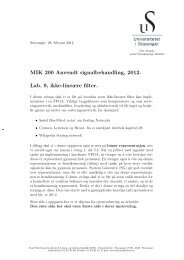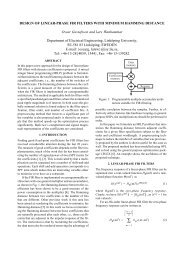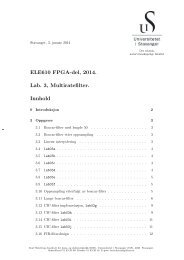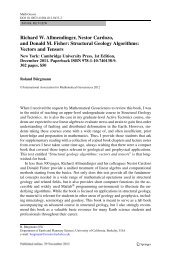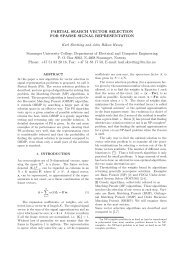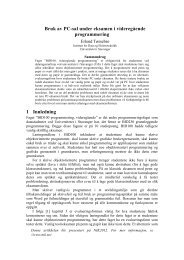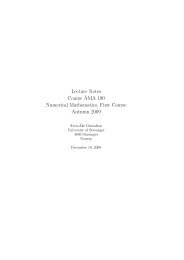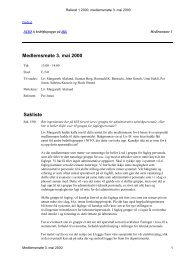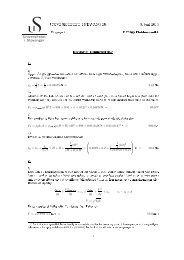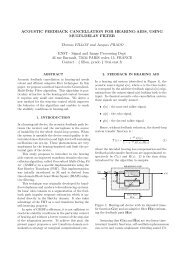Comparison of TCM + RS Coding and Turbo Codes for Spectrally ...
Comparison of TCM + RS Coding and Turbo Codes for Spectrally ...
Comparison of TCM + RS Coding and Turbo Codes for Spectrally ...
You also want an ePaper? Increase the reach of your titles
YUMPU automatically turns print PDFs into web optimized ePapers that Google loves.
the <strong>TCM</strong> concatenated with <strong>RS</strong> coding <strong>for</strong> systemsrequiring high spectral efficiency <strong>and</strong> low delay, restrictingthe delay to a level that is manageable in amodern communication system. In Section 2 we givea short introduction to the different coding schemeswe are focusing on. Then we define the system <strong>and</strong> itsmain parameters in Section 3. Section 4 is devoted tothe per<strong>for</strong>mance <strong>of</strong> the different systems <strong>and</strong> finallywe draw some conclusions in Section 5.2. CODING SCHEMES2.1. Trellis coded modulation concatenated withReed Solomon coding<strong>TCM</strong> was introduced by Ungerboeck in 1976 [10].He showed that <strong>for</strong> b<strong>and</strong>limited channels, substantialcoding gain could be achieved by convolutional coding<strong>of</strong> signal levels (rather than coding <strong>of</strong> binary sourcelevels). He merged coding <strong>and</strong> modulation throughthe use <strong>of</strong> high-order signal constellations, increasingthe Euclidean distance between signal sequences.Reed Solomon codes were introduced in a paperby Reed <strong>and</strong> Solomon in 1960 [3]. They operate overfinite fields <strong>and</strong> are described by consecutive powers<strong>of</strong> a root <strong>of</strong> a primitive polynomial or consecutivezero coordinates in the Galois Field Fourier Trans<strong>for</strong>m<strong>of</strong> code words. They possess a design algorithmto achieve an arbitrary level <strong>of</strong> error correction. ReedSolomon codes are special cases <strong>of</strong> BCH codes whichpossess more rigid structure <strong>and</strong> good distance properties.Reed <strong>and</strong> Solomon published an inefficient decodingalgorithm in their 1960 paper. Berlekamp publishedan efficient decoder in 1967 [11].In this paper we will use the notation <strong>RS</strong>(N,K)to describe a Reed Solomon code with N symbols inthe code word generated from K in<strong>for</strong>mation symbols.This code will be capable <strong>of</strong> correcting (N − K)/2symbol errors in each block <strong>of</strong> length N.Figure 1: Schematic view <strong>of</strong> the concatenated <strong>TCM</strong>+ <strong>RS</strong> system.Figure 2: Schematic view <strong>of</strong> the parallel concatenatedconvolutional turbo coding system.2.2. Parallel concatenated convolutional turbocodesPCC turbo codes are the type <strong>of</strong> codes introducedby Berrou, Glavieux, <strong>and</strong> Thitimajshima in 1993 [12].The encoder consists <strong>of</strong> two or more constituent recursiveconvolutional encoders in parallel, joined throughinterleavers. Proper design <strong>of</strong> the interleavers in theturbo encoder could result in a code with rather largeminimum distance, despite the fact that the constituentcodes are convolutional codes with low minimum distances.Output is taken from the input data <strong>and</strong>the output <strong>of</strong> the convolutional encoders. Outputbits are usually mapped to a signal constellation withGray mapping. To obtain high spectral efficiency,puncturing <strong>of</strong> the turbo code is one possibility. An-other approach is to use high rate, non-punctured constituentcodes where only systematic bits from thesecond component encoder are punctured. We applythe latter technique in our PCC turbo codes.The optimal decoder is computationally intractable.The iterative turbo decoding algorithm is a low complexitysub-optimal decoding algorithm that providesnear Shannon limit per<strong>for</strong>mance across additive whiteGaussian noise (AWGN) channels. The drawback <strong>of</strong>the non-puncturing encoding scheme is the increasedcomplexity <strong>of</strong> the binary iterative turbo decoding algorithm.This can be overcome by considering decodingalgorithms working on a trellis <strong>of</strong> the dualcode [13].
BER−curves, Monte Carlo simulationsBER−curves, Monte Carlo simulations <strong>and</strong> estimated10 −210 −310 −410 −510 −610 −710 −810 −910 −1 E b/N 0[dB]10 −10BER10 −15PCC code, interleaver 1PCC code, interleaver 2PCC code, interleaver 3128<strong>TCM</strong> + <strong>RS</strong>(255,243)256<strong>TCM</strong> + <strong>RS</strong>(255,211)13 13.5 14 14.5 15 15.5 16 16.5 17 17.510 −2010 −5 E b/N 0[dB]BERPCC code, interleaver 1, Part 1 + 2PCC code, interleaver 2, Part 1 + 2PCC code, interleaver 3, Part 1 + 2128<strong>TCM</strong> + <strong>RS</strong>(255,243), Part 1 + 2256<strong>TCM</strong> + <strong>RS</strong>(255,211), Part 1 + 213 13.5 14 14.5 15 15.5 16 16.5 17 17.5 18Figure 3: Bit error rate as a function <strong>of</strong> E b /N 0 <strong>for</strong> thedifferent coding schemes. Monte Carlo simulations.η = 6.2 bit/s/Hz.occur within a block. This simplification has only minoreffect on the results.A BER below 10 −13 is required in many communicationnetworks. This is however not practicalto simulate in a Monte Carlo simulation. Figure 4there<strong>for</strong>e shows estimated curves <strong>for</strong> the error floors<strong>of</strong> the turbo codes <strong>and</strong> estimated upper bounds <strong>for</strong>the <strong>TCM</strong>+<strong>RS</strong> BER-curves (part 2 <strong>of</strong> curves). Thecurves from the Monte Carlo simulations are kept inthis plot <strong>for</strong> comparison (part 1 <strong>of</strong> curves). The errorfloors <strong>of</strong> the turbo codes are estimated with the unionbounding technique as described in [20]. The upperbound BER-curves <strong>for</strong> <strong>TCM</strong>+<strong>RS</strong> are estimated withthe technique presented in [14], p. 333. This techniquetakes the BER be<strong>for</strong>e <strong>RS</strong> decoding as input, <strong>and</strong>these values were found in a Monte Carlo simulation<strong>of</strong> a system with <strong>TCM</strong> only. The method also assumesperfect interleaving (independent errors), <strong>and</strong> the actualBER will be higher than this upper bound in asystem with burst errors <strong>and</strong> poor interleaving. Witha good choice <strong>of</strong> interleaver, it is possible to achieveBERs close to or even below this upper bound also <strong>for</strong>interleavers with moderate delay. As we can see fromFigure 4, the slope <strong>of</strong> the simulated <strong>TCM</strong>+<strong>RS</strong> BERcurveis not as steep as the estimated upper bound<strong>for</strong> low BERs. We note that the lines cross at a BERabout 10 −7 . This is due to the delay restrictions whichresulted in the choice <strong>of</strong> the interleaver with B = 8<strong>and</strong> M = 31. The <strong>TCM</strong> + <strong>RS</strong> code will howevernot give an error floor, as is the case <strong>for</strong> the PCCturbo codes, <strong>and</strong> the curve is expected to follow theestimated upper bound quite well also <strong>for</strong> low BERs.From Figures 3 <strong>and</strong> 4 we can see that the 128<strong>TCM</strong>-4D combined with <strong>RS</strong>(255,243) has better per<strong>for</strong>manceFigure 4: Bit error rate as a function <strong>of</strong> E b /N 0 <strong>for</strong>the different coding schemes. Part 1 <strong>of</strong> curves: MonteCarlo simulations. Part 2 <strong>of</strong> curves: Estimated curves<strong>for</strong> low BERs. η = 6.2 bit/s/Hz.than the 256<strong>TCM</strong>-4D combined with <strong>RS</strong>(255,211).Even though the latter curve is steeper <strong>and</strong> will eventuallycross the other line, this will happen at a BERfar below the region <strong>of</strong> interest. For the same spectralefficiency a high rate <strong>RS</strong> code concatenated witha suitable <strong>TCM</strong> seems to be better than a more powerful<strong>RS</strong> code concatenated with a more spectral efficient<strong>TCM</strong>. In the further discussion, only the 128<strong>TCM</strong>-4D + <strong>RS</strong>(255,243) will be considered.For the turbo codes we can see that it is possible tooptimize the code with respect to the error floor <strong>and</strong>achieve an error floor well below 10 −13 (interleavers2 <strong>and</strong> 3). This is achieved through a smart design <strong>of</strong>the bit-interleaver as described in [20]. A very lowerror floor will however degrade the per<strong>for</strong>mance inthe waterfall region (BER between 10 −3 <strong>and</strong> 10 −9 ).The turbo code has 0.6 dB higher E b /N 0 at BER =10 −6 with interleaver 3 compared to interleaver 1.When comparing the turbo codes to the <strong>TCM</strong>+<strong>RS</strong>code, we can see that the turbo codes give a gain <strong>of</strong>1.1 - 1.8 dB at BER = 10 −6 . The curves <strong>for</strong> the turbocodes have however an error floor, i.e. the curve is notas steep as the <strong>TCM</strong>+<strong>RS</strong> curve at low BERs. Atsome point the curves will there<strong>for</strong>e cross. The turbocode with the best per<strong>for</strong>mance at BER = 10 −6 (interleaver1) has the highest error floor, <strong>and</strong> crossesthe <strong>TCM</strong>+<strong>RS</strong> curve above BER = 10 −13 . The errorfloors <strong>of</strong> the turbo codes with interleavers 2 <strong>and</strong>3 cross the <strong>TCM</strong>+<strong>RS</strong> curve below a BER <strong>of</strong> 10 −19 .Consequently these turbo codes have better per<strong>for</strong>mancethan the <strong>TCM</strong>+<strong>RS</strong> code <strong>for</strong> all BERs <strong>of</strong> interest.The improvement is at the cost <strong>of</strong> higher complexity,which in turn might increase the delay when
the limited processing speed in an implementation isincluded in the delay budget. The per<strong>for</strong>mance <strong>of</strong> the<strong>TCM</strong>+<strong>RS</strong> code might be improved by increasing thenumber <strong>of</strong> states in the trellis code. This improvementis also at the cost <strong>of</strong> higher complexity, but thedelay will not change much.5. CONCLUSIONSThis paper compares the per<strong>for</strong>mance <strong>of</strong> concatenated<strong>TCM</strong>+<strong>RS</strong> to that <strong>of</strong> PCC turbo codes <strong>for</strong> systemsrequiring very high spectral efficiency <strong>and</strong> low delay.We have shown that it is possible to design PCC turbocodes with better per<strong>for</strong>mance than <strong>TCM</strong>+<strong>RS</strong> <strong>for</strong> allrelevant BERs. When a low error floor is required,the gain is about 1.5 dB at BER = 10 −6 . Because<strong>of</strong> the error floor <strong>of</strong> the PCC turbo codes, the curveswill cross. However, with careful design <strong>of</strong> the PCCcode, the crossing is at a level <strong>of</strong> minor interest inmost applications. The improvement is at the cost <strong>of</strong>higher complexity, which in turn might increase thedelay when the limited processing speed in an implementationis included in the delay budget. The per<strong>for</strong>mance<strong>of</strong> the <strong>TCM</strong>+<strong>RS</strong> code might be improvedby increasing the number <strong>of</strong> states in the trellis code.This improvement is also at the cost <strong>of</strong> higher complexity,but the delay will not change much.6. REFERENCES[1] G. Ungerboeck, “Trellis-coded modulation withredundant signal sets, part I: Introduction,”IEEE Communications Magazine, vol. 25, pp. 5–11, February 1987.[2] L.-F. Wei, “Trellis-coded modulation with multidimensionalconstellations,” IEEE Trans. onIn<strong>for</strong>mation Theory, vol. 33, pp. 483–501, July1987.[3] I. Reed <strong>and</strong> G. Solomon, “Polynomial codesover certain finite fields,” Journal <strong>of</strong> the Society<strong>for</strong> Industrial <strong>and</strong> Applied Mathematics, vol. 8,pp. 300–304, June 1960.[4] C. Berrou <strong>and</strong> A. Glavieux, “Near optimum errorcorrection coding <strong>and</strong> decoding: <strong>Turbo</strong>-codes,”IEEE Trans. on Communications, vol. 44,pp. 1261–1271, October 1996.[5] R. M. Pyndiah, “Near optimum decoding <strong>of</strong>product codes: Block turbo codes,” IEEE Trans.on Communications, vol. 46, pp. 1003–1010, August1998.[6] R. G. Gallager, Low-Density Parity-Check <strong>Codes</strong>.Cambridge, Massachusettes: M.I.T Press, 1963.[7] D. J. C. MacKay, “Good error-correcting codesbased on very sparse matrices,” IEEE Trans. onIn<strong>for</strong>mation Theory, vol. 45, pp. 399–431, March1999.[8] J. Li, K. R. Narayanan, <strong>and</strong> C. N. Georghiades,“Product accumulate codes: A class<strong>of</strong> capacity-approaching, low complexitycodes,” IEEE Trans. on In<strong>for</strong>mation Theory,submitted <strong>for</strong> publication, June 2001,http://ee.tamu.edu/~krishna/.[9] T. Flo, P. Orten, <strong>and</strong> B. Risløv, “Evaluation<strong>of</strong> coding schemes <strong>for</strong> spectrally efficient lowdelayradio systems,” in Proc. <strong>of</strong> 3rd InternationalSymp. on <strong>Turbo</strong> <strong>Codes</strong> & Related Topics,(Brest, France), pp. 387–390, September 2003,preprint accepted <strong>for</strong> publication.[10] G. Ungerboeck, “On improving data-link per<strong>for</strong>manceby increasing channel alphabet <strong>and</strong> introducingsequence coding,” in Proc. <strong>of</strong> IEEE InternationalSymp. on In<strong>for</strong>mation Theory (ISIT),(Ronneby, Sweden), June 1976.[11] E. Berlekamp, Algebraic coding theory. NewYork: McGraw-Hill, 1968.[12] C. Berrou, A. Glavieux, <strong>and</strong> P. Thitimajshima,“Near Shannon limit error-correcting coding <strong>and</strong>decoding: <strong>Turbo</strong>-codes,” in Proc. <strong>of</strong> IEEE InternationalConference on Communications (ICC),(Geneva, Switzerl<strong>and</strong>), pp. 1064–1070, vol. 2,May 1993.[13] S. Riedel, “MAP decoding <strong>of</strong> convolutional codesusing reciprocal dual codes,” IEEE Trans. on In<strong>for</strong>mationTheory, vol. 44, pp. 1176–1187, May1998.[14] G. C. Clark, Jr. <strong>and</strong> J. B. Cain, Error-Correction<strong>Coding</strong> <strong>for</strong> Digital Communications. PlenumPress, third ed., 1988.[15] S. N. Crozier, “New high-spread high-distance interleavers<strong>for</strong> turbo-codes,” 2001, preprint.[16] K. S. Andrews, C. Heegard, <strong>and</strong> J. Kozen, “Interleaverdesign methods <strong>for</strong> turbo codes,” inProc. <strong>of</strong> IEEE International Symp. on In<strong>for</strong>mationTheory (ISIT), (Boston, MA), p. 420, August1998.[17] M. Breiling, S. Peeters, <strong>and</strong> J. Huber, “Interleaverdesign using backtracking <strong>and</strong> spreadingmethods,” in Proc. <strong>of</strong> IEEE International Symp.on In<strong>for</strong>mation Theory (ISIT), (Sorrento, Italy),p. 451, June 2000.
[18] “Multiplexing <strong>and</strong> channel coding (FDD),” 3rdGeneration Partnership Project, June 1999, 3GTS 25.212.[19] E. Rosnes <strong>and</strong> Ø. Ytrehus, “Improved algorithms<strong>for</strong> the determination <strong>of</strong> turbo code weight distributions,”IEEE Trans. on Communications, accepted<strong>for</strong> publication, 2003.[20] E. Rosnes <strong>and</strong> Ø. Ytrehus, “On lowering the errorfloor <strong>of</strong> bit-interleaved turbo-coded modulation,”2003, preprint.



